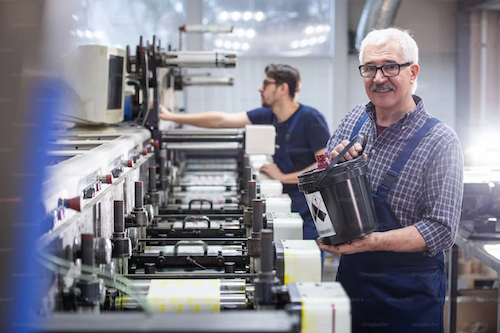According to Focus Label Machinery, printers and manufacturers are often on the lookout for more sustainable printing options, which is one reason why dye sublimation has gained popularity in the textile industry.
Widely used to print ribbons, elastics, hi-tech sports clothing, flags, and promotional products, dye sublimation offers important advantages over traditional printing techniques, but also poses some limitations.
What Is Involved In Dye Sublimation?
Dye sublimation is a printing method that uses a specially printed paper to retain a solid ink image. The ink is heated by the printer until it sublates (instead of turning to liquid, it converts directly into a gaseous state).
The Dye Sublimation Process Involves Two Main Steps:
Firstly, a negative image is printed onto a sacrificial transfer paper, which is a special paper that is designed to retain and release ink onto the substrate that is to be printed, usually by a flexographic or digital process.
Next, the printed image is transferred onto a textile substrate using heat and pressure. Typically, the substrate is made of polyester fabric or a coated surface. The process allows the ink to permeate the fabric, resulting in vibrant, high-quality images with exceptional colour accuracy and durability.
What Are The Benefits Of Sublimation Printing?
Incredible vibrancy: dye sublimation produces extremely vivid and eye-catching images, increasing the aesthetic appeal and saleability of printed products.
Image quality: with dye sublimation, colours are blended seamlessly on the printed substrate to create a high-quality image. With other printing methods, such as inkjet printing, close inspection or magnification of the image will often reveal the primary colour dots, although this is harder to see at a distance.
Sustainability: the dye sublimation process is considered more environmentally friendly than traditional printing methods as it generates less waste, consumes less energy and water, and uses non-toxic inks that don’t cause ecological damage.
Are There Any Downsides To Dye Sublimation?
Dye sublimation is only successful on polyester based textiles. Another drawback is the time it takes to complete the two stage process, (a) to print the paper and (b) to transfer the image to a textile. The transfer process is slow since the ink needs time to transfer and bond with the substrate, and it generally takes longer than other printing methods, which can be a limitation in situations where quick turnaround times are required.
A potential limitation is the size of the substrate that can be printed. In larger format printing applications, the size of the heat press may impose restrictions on the maximum size of the substrate. This can be a challenge when working on projects that demand oversized prints or large-scale designs.
However, despite these limitations, the benefits of dye sublimation printing outweigh the disadvantages, especially for applications that require vibrant and durable colours. It continues to be a preferred choice in the textile industry due to its ability to produce stunning and long-lasting prints on polyester fabrics.
FOCUS LABEL MACHINERY
jamesb@focuslabel.com
https://www.focuslabel.com















